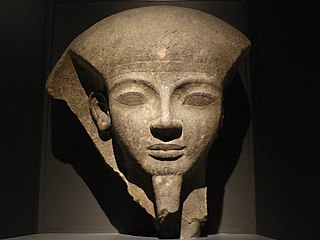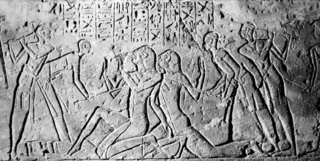Related Research Articles

The Philistines were an ancient people who lived on the south coast of Canaan during the Iron Age in a confederation of city-states generally referred to as Philistia.

Usermaatre Meryamun Ramesses III was the second Pharaoh of the Twentieth Dynasty in Ancient Egypt. He is thought to have reigned from 26 March 1186 to 15 April 1155 BC and is considered to be the last great monarch of the New Kingdom to wield any substantial authority over Egypt.

The Sea Peoples are a hypothesized seafaring confederation that attacked ancient Egypt and other regions in the East Mediterranean before and during the Late Bronze Age collapse. Following the creation of the concept in the 19th century, the Sea Peoples' incursions became one of the most famous chapters of Egyptian history, given its connection with, in the words of Wilhelm Max Müller, "the most important questions of ethnography and the primitive history of classic nations".

The Battle of Kadesh took place between the Egyptian Empire and the Hittite Empire in the 13th century BC, with the former led by Ramesses II and the latter led by Muwatalli II. Both sides engaged each other at the Orontes River, just upstream of Lake Homs and near the archaeological site of Kadesh, along what is today the Lebanon–Syria border.

The Turin King List, also known as the Turin Royal Canon, is an ancient Egyptian hieratic papyrus thought to date from the reign of Pharaoh Ramesses II, now in the Museo Egizio in Turin. The papyrus is the most extensive list available of kings compiled by the ancient Egyptians, and is the basis for most chronology before the reign of Ramesses II.
Medjay was a demonym used in various ways throughout ancient Egyptian history to refer initially to a nomadic group from Nubia and later as a generic term for desert-ranger police.

Khepermaatre Ramesses X was the ninth pharaoh of the 20th Dynasty of Ancient Egypt. His birth name was Amonhirkhepeshef. His prenomen or throne name, Khepermaatre, means "The Justice of Re Abides."

Menmaatre Ramesses XI reigned from 1107 BC to 1078 BC or 1077 BC and was the tenth and final pharaoh of the Twentieth Dynasty of Egypt and as such, was the last king of the New Kingdom period. He ruled Egypt for at least 29 years although some Egyptologists think he could have ruled for as long as 30. The latter figure would be up to 2 years beyond this king's highest known date of Year 10 of the Whm Mswt era or Year 28 of his reign. One scholar, Ad Thijs, has suggested that Ramesses XI could even have reigned as long as 33 years.

Kamose was the last Pharaoh of the Theban Seventeenth Dynasty. He was possibly the son of Seqenenre Tao and Ahhotep I and the brother of Ahmose I, founder of the Eighteenth Dynasty. His reign fell at the very end of the Second Intermediate Period. Kamose is usually ascribed a reign of three years, although some scholars now favor giving him a longer reign of approximately five years.

Ramesses VI Nebmaatre-Meryamun was the fifth ruler of the Twentieth Dynasty of Egypt. He reigned for about eight years in the mid-to-late 12th century BC and was a son of Ramesses III and queen Iset Ta-Hemdjert. As a prince, he was known as Ramesses Amunherkhepeshef and held the titles of royal scribe and cavalry general. He was succeeded by his son, Ramesses VII Itamun, whom he had fathered with queen Nubkhesbed.

Usermaatre Setepenre Meryamun Ramesses VII was the sixth pharaoh of the 20th Dynasty of Ancient Egypt. He reigned from about 1136 to 1129 BC and was the son of Ramesses VI. Other dates for his reign are 1138–1131 BC. The Turin Accounting Papyrus 1907+1908 is dated to Year 7 III Shemu day 26 of his reign and has been reconstructed to show that 11 full years passed from Year 5 of Ramesses VI to Year 7 of his reign.

Sir Alan Henderson Gardiner, was an English Egyptologist, linguist, philologist, and independent scholar. He is regarded as one of the premier Egyptologists of the early and mid-20th century.

The Story of Wenamun is a literary text written in hieratic in the Late Egyptian language. It is only known from one incomplete copy discovered in 1890 at al-Hibah, Egypt, and subsequently purchased in 1891 in Cairo by the Russian Egyptologist Vladimir Golenishchev. It was found in a jar together with the Onomasticon of Amenope and the Tale of Woe.

The Peleset or Pulasati are a people appearing in fragmentary historical and iconographic records in ancient Egyptian from the Eastern Mediterranean in the late 2nd millennium BCE. They are hypothesised to have been one of the several ethnic groups the Sea Peoples were said to be composed of.
Papyrus Hood is a hieratic papyrus from the time of 21st Dynasty Pharaoh Amenemope, 993–984 BC. The papyrus is at the British Museum,, and is a cursive hieratic manuscript which contains a copy of the Onomasticon of Amenope. This Third Intermediate Period work is known from eight other fragmentary copies, and relates back to the late New Kingdom era.

The Twentieth Dynasty of Egypt is the third and last dynasty of the Ancient Egyptian New Kingdom period, lasting from 1189 BC to 1077 BC. The 19th and 20th Dynasties furthermore together constitute an era known as the Ramesside period. This dynasty is generally considered to be the start of the decline of Ancient Egypt at the transition from the Late Bronze to Iron Age. During the period of the Twentieth Dynasty, Ancient Egypt facing the crisis from the invading of See Peoples, but have successfully defend Egypt, while still been heavy damage.
This page list topics related to ancient Egypt.

Neferkasokar was an Ancient Egyptian king (pharaoh) who may have ruled in Egypt during the 2nd Dynasty. Very little is known about him, since no contemporary records about him have been found. Rather his name has been found in later sources.

The Wilbour Papyrus, named after the New York journalist who acquired it, Charles Edwin Wilbour, is the largest known non-funerary papyrus from Ancient Egypt. It is an administrative document which contains a survey of cultivatable lands in the late Ramesside Period of the New Kingdom of Egypt. The papyrus is 10 meters long and divided into two sections, text A and text B. Text A contains an extensive account of lands both privately and collectively owned. Text B is much shorter and contains an account of exclusively royal lands. The Wilbour Papyrus is a rare case of a well preserved look into the economic administration of Ancient Egypt. Egyptologists have been able to use it to produce a more complete analysis of the function of the Ancient Egyptian state.

The Kadesh inscriptions or Qadesh inscriptions are a variety of Egyptian hieroglyphic inscriptions describing the Battle of Kadesh. The combined evidence in the form of texts and wall reliefs provide the best documented description of a battle in all of ancient history.
References
- 1 2 Medjay in the Onomasticon of Amenenope: "The Onomasticon of Amenemope was originally composed at the end of the Twentieth Dynasty, no earlier than the reign of Ramesses IX. Nine copies of the manuscript exist, all of which date to Dynasties Twenty-one or Twenty-two. The term ‘Medjay’, no. 188, appears in only two of copies of this text, namely in the Golenischeff copy and in a copy made up of a few papyrus fragments from the Ramesseum. The Golenischeff copy, an early Twenty-first Dynasty version, is the most comprehensive and complete."
- ↑ I. S. Edwards, N. G. L. Hammond, C. J. Gadd, The Cambridge Ancient History, Cambridge University Press 1975, p.531
- 1 2 Jack Goody, The Domestication of the Savage Mind, Cambridge University Press 1997, p.101
- ↑ Werner Hüllen, English Dictionaries, 800-1700: The Topical Tradition, Oxford University Press, 1999, p. 31.
- ↑ HERBIN, F.R., 1986, « Une version inachevée de l’onomasticon d’Aménémopé », BIFAO, 1986, pp 187-198.
- ↑ Gardiner, Alan H. (1947). Ancient Egyptian Onomastica, Volume I. Oxford University Press. pp. Autographed text, 2*.
- ↑ Gardiner, Alan H. (1947). Ancient Egyptian Onomastica, Volume I. Oxford University Press. p. 37.
- ↑ Jack Goody, The Logic of Writing and the Organization of Society, Cambridge University Press 1986, pp.34f
- ↑ Carl S. Ehrlich, The Philistines in Transition: A History of the Philistines from Ca. 1000-730 B. C. E., Brill 1996, p.7
- ↑ Lowell K. Handy, The Age of Solomon: Scholarship at the Turn of the Millennium, Brill 1997, p.184